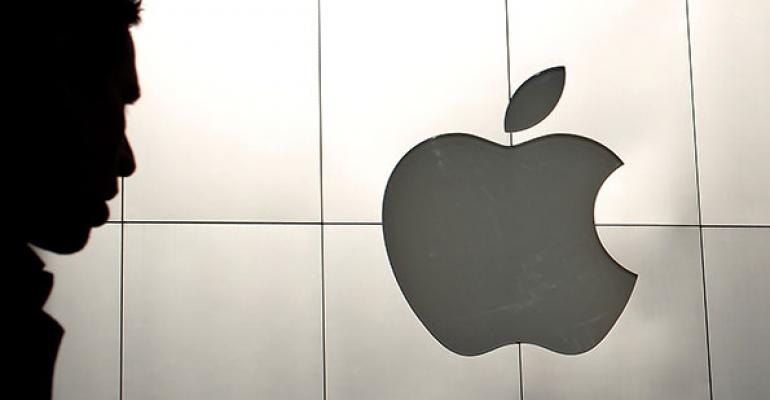(Bloomberg) -- There aren't too many things worse for ETFs than a rotten Apple.
When Apple has a bad run, it is devastating to many ETF investors. In the past two weeks, Apple has basically erased more than $4 billion in ETF assets during its 16.3 percent decline that was triggered by a disappointing earnings report. It gave the SPDR S&P 500 ETF Trust (SPY) a $1 billion haircut in a matter of days, not to mention wiping out hundreds of millions of dollars out of several other popular ETFs as seen in the table below which sorts ETFs by the size of Apple’s bite.
ETFs as a whole own about $26 billion worth of Apple stock (down from $30 billion two weeks ago), which comes out to about 5 percent of the company's shares outstanding. Apple alone has more weighting inside ETFs than the entire country of China. The technology giant is in 183 ETFs, or about 10 percent of them, and is the top holding in five of the six largest ETFs.
The reason Apple's dominance inside a diversified fund is that the vast majority of the big-time ETFs weight their holdings by the stock's market cap. So as a company grows, it gets a bigger and bigger weighting. In short, these ETFs live by the big stock sword but they also die by the big stock sword.
For example, the Technology Select Sector SPDR Fund (XLK) is down 5.3 percent in the past two weeks with Apple alone contributing nearly half of that negative performance thanks to its outsized 16 percent weighting. Meanwhile, Facebook's 6 percent rally during the same time period wasn’t nearly enough to offset losses because it has half the weighting that Apple does. On the flip side (and there's always a flip side), the large weighting to Apple has been more than kind to XLK in the past seven years, contributing nearly 40 percent of XLK’s 200 percent return. In short, Apple is the LeBron James to XLK’s Cleveland Cavaliers.
Limitations posed by this kind of reliance on gigantic stocks is basically why God created smart-beta ETFs. Smart-beta refers to strategies that weight stocks based on something other than market cap. For example, the Guggenheim S&P 500 Equal Weight Technology ETF (RYT) equally weights all the tech companies in the S&P 500 index. As such, Apple’s 16 percent decline was barely felt in RYT since it only gives the stock a 1.3 percent weight- the same as every other tech stock. The chart below shows how RYT held up better than XLK.
The other ETF in the chart is the PowerShares DWA Technology Momentum Portfolio (PTF), which only fell 1.9 percent because it gave Apple the boot back in January because it screens and weights stocks based on their performance and relative strength versus their peers. Apple – which was a 5 percent weight in PTF at the beginning of year - had a foreshadowing 7 percent selloff in January that was enough to get it screened out of PTF in its rebalance just before the big one hit in April.
Smart-beta doesn’t always work out so nicely, but RYT and PTF’s performance during the past two weeks give a glimpse into why it is an increasingly compelling alternative to investors and growing faster than ETFs as a whole.
Besides being about three times as cheap as a purely active mutual fund or ETF, they also lack the ego, emotion and biases of a human being. Kicking the world’s largest company out of a popular fund is easier said than done for a living, breathing portfolio manager with clients to answer to. But to these mindless, robotic ETFs it is no problem as they are just following the pre-set rules of the index. It is in these disciplined rebalances and forced trades where smart-beta products tend to pick up most of their alpha.
If this is the beginning of a long slide for Apple, look out for smart-beta products to have some breakout performances. If it is just a short-term correction, like times past, than market cap weighting will continue slaying new school weighting schemes with its big stock swords.
Eric Balchunas is an exchange-traded-fund analyst at Bloomberg. This piece was edited by Bloomberg News.
To contact the author of this story: Eric Balchunas in Skillman at [email protected] To contact the editor responsible for this story: Joe Weisenthal at [email protected]





